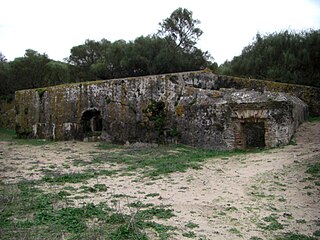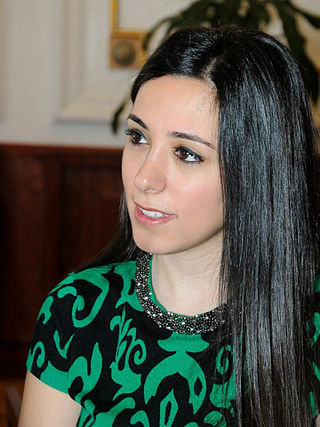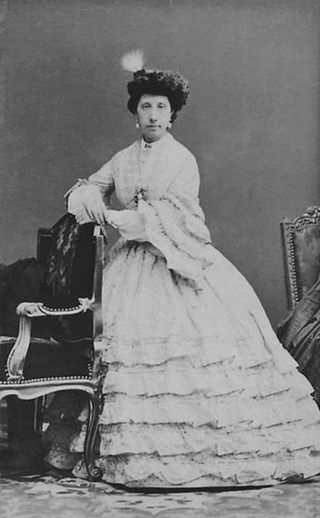Contents
This article needs additional citations for verification .(June 2018) |
| |||||
| Decades: | |||||
|---|---|---|---|---|---|
| See also: | Other events of 1835 List of years in Spain | ||||
Events from the year 1835 in Spain.
This article needs additional citations for verification .(June 2018) |
| |||||
| Decades: | |||||
|---|---|---|---|---|---|
| See also: | Other events of 1835 List of years in Spain | ||||
Events from the year 1835 in Spain.

Maria Christina of the Two Sicilies was the Queen of Spain from 1829 to 1833 and Queen regent of the kingdom from 1833, when her daughter became queen at age two, to 1840. By virtue of her short marriage to King Ferdinand VII of Spain, she became a central character in Spanish history for nearly 50 years, thanks to introducing a bicameral model of government based on the Bourbon Restoration in France: the Spanish Royal Statute of 1834.

José María Queipo de Llano y Ruiz de Saravia, 7th Count of Toreno, GE, was a nineteenth-century Spanish politician and historian, who was President of Spain.

The Treaty of Fontainebleau was a secret agreement signed on 27 October 1807 in Fontainebleau, France between King Charles IV of Spain and the French Emperor Napoleon. Under the treaty, the House of Braganza was to be driven from the Kingdom of Portugal with the country subsequently divided into three regions, the north and south to be ruled by Duke of Parma and Spanish minister Manuel Godoy respectively, while the provinces of Beira, Tras-os-Montes and Portuguese Estremadura would remain in abeyance until a later peace. Within seven months the government of Spain had collapsed and two Spanish kings abdicated. In August 1808 Napoleon imposed his brother Joseph as King of Spain.

The Diocese of Jaén is a Latin Church diocese of the Catholic Church in the city of Jaén in the ecclesiastical province of Granada in Spain.

The Roman Catholic Archdiocese of La Paz is an archdiocese located in the city of La Paz in Bolivia.
Queipo is a surname. Notable people with the surname include:

H.E. Don Francisco de Borja Queipo de Llano y Gayoso de los Cobos, Grandee of Spain, 8th Count of Toreno and 8th Viscount of Matarrosa was a Spanish noble and politician. He served as Minister of State between 1875 and 1879, and was also appointed Mayor of Madrid. His father was President of Spain and his great-grandmother was the Princess of Anglona of the Borja family. He is named after his ancestor Francisco de Borja y Aragon, great-grandson of both Pope Alexander VI and King Ferdinand II of Aragon. His descendants are also the Count of Toreno, Marquess of Guadiaro, Count of Casares, Count of Belalcazar, Countess of San Martín de Quiroga, Viscount of Valoria, Duke of Monteagudo, Count of Mayorga, Count of San Martín de Quiroga, and Viscount of Matarrosa.
Count of Toreno Grandee of Spain is a title in the Spanish nobility. The title was first bestowed on Álvaro Queipo de Llano by Philip IV of Spain in 1657.

Ponciano Ponzano y Gascón was a Spanish neoclassical sculptor. A prolific artist, in his day he was highly esteemed. His work is now largely forgotten, although it can still be seen in many public locations.

Gonzalo Queipo de Llano y Sierra was a Spanish Army general. He distinguished himself quickly in his career, fighting in Cuba and Morocco, later becoming outspoken about military and political figures which led to his imprisonment, removal from posts and involvement in plots against Spanish governments. He was a Nationalist military leader during the Spanish Civil War under Francisco Franco, gaining the soubriquet "El general de la radio" for his threats and explicitness on air. Under his control of southern Spain, tens of thousands of Spaniards perished as part of the Nationalists' White Terror. In his post-war roles he was effectively sidelined by Franco.

Batería de San Genís is a battery located in San Fernando in the Province of Cádiz, Andalusia, Spain. It is part of the whole defensive system of bastions and batteries that protected the southern entrance of Islote de Sancti Petri in the early nineteenth century along with the Castillo de Sancti Petri and two batteries, Batería de Aspiroz and Batería de Urrutia. It was named after Sangenís Antonio Torre, and was capable of holding 35 pieces of artillery. It was protected under the general declaration of the Decree of April 22 of 1949 and Law 16/1985 by the Patrimonio Histórico Españo.

Hanna, Marchioness of Guadiaro is an American-born Mexican television personality who runs the non-profit Jaff Foundation for Education. She is married to Francisco de Borja Queipo de Llano y Campomanes, 6th Marquess of Guadiaro and eldest son of the 12th Count of Toreno and Grandee of Spain.

Infanta Josefa Fernanda of Spain was an infanta of Spain, whom married morganatically to José Güell y Renté. She was a daughter of Infante Francisco de Paula and his first wife, Princess Luisa Carlotta of the Two Sicilies.

Infanta Isabel Fernanda of Spain was a Spanish princess and the eldest child of Infante Francisco de Paula of Spain and of his niece, Princess Luisa Carlotta of the Two Sicilies.
José Fernández de Villa-Abrille y Calivara was a Spanish general in charge of the Seville garrison who capitulated to rebel forces at the beginning of the Spanish Civil War.

The river Cúa is situated in the north of the region of El Bierzo in the province of León, autonomous community of Castilla y León (Spain). It rises in the Campo de la Pesca, near the port of Cienfuegos and flows into the river Sil at Toral de los Vados. The tributaries of some importance on the right are the Ancares and Burbia rivers and of lesser volume on the left: the aforementioned Arroyo de Trayecto, the Faro river and the Biarzas river.
José Cuesta Monereo was a senior Spanish army officer, regarded as the planner of the Spanish coup of July 1936 in Seville at the beginning of the Spanish Civil War, and thereafter other areas, initially under the command of general Gonzalo Queipo de Llano. The plans resulted in the abuse, torture and murder of thousands of local people.